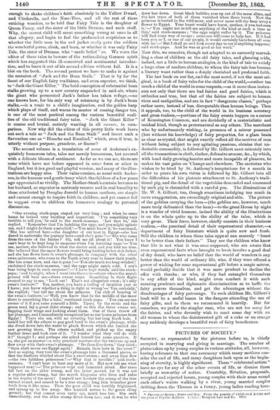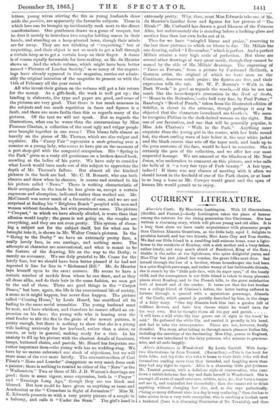PICTURES OF SOCIETY.*
SOCIETY, as represented by the pictures before us, is chiefly occupied in marrying and giving in marriage. The number of plates taken up by young couples in various attitudes, all, however, having reference to that one ceremony which many mothers con- sider the end of life, and many daughters look upon as the begin- ning of eternity, is highly significant. These " celebrated artists " have no eye for any of the other events of life, or dismiss them briefly as unworthy of notice. Courtship, flirtation, proposals, accepted and rejected lovers, young couples with their arms rota d each other's waists walking by a river, young married couples drifting down the Thames in a funny, young ladies reading love-
* Pictures of Society; Grare end Qey. From the pencils of Celebrated Artists and the peas or Porular Authors. Lusby : Sampson Low and Co. 1866.
letters, young wives stirring the fire as young husbands draw aside the portiere, are apparently the favourite subjects. Those in
which love can be brought up incidentally rank next to the direct manifestations. One gentleman draws us a game of croquet, but he does it merely to introduce two couples holding maces in their hands, and standing on a hoop-planted lawn, though their minds are far away. They are not thinking of " roquetting," but of coquetting, and their object is not so much to get a ball through a certain hoop as to get a certain hoop on their finger. A dance is of coarse equally favourable for love-making, as Mr. do Maurier shows us. And the whole volume, which might have been better named "Pictures of London Society," as so many of the engrav- ings have already appeared in that magazine, carries out admir- ably the original intention of the magazine to present us with the 14th of February all the year round.
All who invest their guinea on the volume will get a fair return for the money. As a gift-book, the work is well got up ; the binding is elaborate, the type and paper are good, and some of the pictures are very good. That there is too much sameness in the subjects and too much repetition in faces and figures is a fault, and there are more faults than this as regards many of the pictures. Of the text we will not speak. But as regards the illustrations, what can be worse than the conversazione by Miss Florence Claxton, a collection of the most ugly and vulgar people ever brought together in one room? This blame falls almost as heavily on the pieces of Mr. Thomas, which are also vulgar and repulsive. His " Fancy Fair " represents a snob grinning over a counter at a young lady, who seems to have put on the manners of a pert shop-girl with the congenial occupation. His "Spring in the Park" gives us a rusty old gentleman on a broken-kneed hack, scowling at the ladies of his party. We have only to consider what Leech would have made out of this subject to appreciate the depth of Mr. Thomas's failure. But almost all the kindred pictures in the book are bad. Mr: C. H. Bennett, who can both observe and draw when he chooses, is coarse and strained in his his picture called "News." There is nothing characteristic of their occupation in the heads he has given us, except a certain eagerness and absorption, indicated rather than worked out. Mr. McConnell was never much of a favourite of ours, and we are not surprised at finding his " Brighton Beach " peopled with men and women without foreheads, but with prominent noses. The picture " Croquet," to which we have already alluded, is worse than that allusion would imply ; the game is not going on, the couples are everything, and they are not even pretty. This system of choos- ing a subject not for the subject itself, but for what can be brought into it, is shown in Mr. Walter Crane's pictures. In the " Going to the Derby " we have an extremely pretty face, a really lovely face, in one carriage, and nothing more. The attempts at character are conventional, and what is meant to be the feature of the drawing, life on the way to the Derby, is merely an accessary. We are duly grateful to Mr. Crane for the lovely face, but we should have been better pleased if he had not repeated it line for line in " Richmond Hill." Mr. du Maurier lays himself open to the same censure. He seems to have a certain number of models from whom he can draw, and as they all dress alike, and do their hair in the same fashion, we soon get to the end of them. There are good things in the " Carpet Dance," but here, again, the life is the conventional life of society, a scene as it might happen, but never does happen. The picture called " Coming Home," by Louis Huard, has sacrificed all its feeling to the same social necessities. The young husband must be neat, and have whiskers, and therefore he cannot afford an ex- pression on his face ; the young wife who is leaning over the steel fender to stir the fire in the grate of the newest pattern, is pretty enough, but there is nothing to show that she is a young wife looking anxiously for her husband, rather than a sister, or cousin, or lady in general, making ready for a visit. In his anxiety to fill up his picture with the chastest details of furniture, lamps, buttoned chairs, and pastels, Mr. Huard has forgotten one rather important item—the young wife has no wedding-ring. We have by no means exhausted our stock of objections, but we will state some of the rest more briefly. The conventionalism of Carl Pilotz's " Hero and Leander" disappoints us very much from such a painter; there is nothing to remind us either of the "Nero" or the " Wallenstein." Two or three of Mr. J. D. Watson's drawings are good ; there is some vigour, some expression, both in " Prayer " and " Evenings Long Ago," though they are too black and blurred. But how could he have given us anything so tame and Academical as the " Crusaders in Sight of Jerusalem ?" Miss M E. Edwards presents us with a very pretty picture of a couple in a balcony, and calls it " Under the Stars." The girl's head is extremely pretty. Why, then, must Mies Edwards take one of Mr. du Mainier's familiar faces and figures for her picture of " The Rivals?" Mr. Corbould has drawn a good likeness of the Princess Alice, but unfortunately she is standing before a looking-glass and another face than her own looks out of it.
Thus far we have "mingled blame and praise," reserving to the last those pictures to which no blame is due. Mr. Millais has one drawing, called " I Remember," which is perfect. And a perfect Millais attains a very high scale of perfection. But there are several other drawings of very great merit, though they cannot be named by the side of Mr. Millais' drawings. The engraving of " Tasso at Ferrara," from a picture by Ferdinand fleilbuth, a German artist, the original of which we have seen on the Continent, deserves much praise ; the figures are fine, and their expression tells the tale. Mr. W. P. Burton's " Walk in the Dark Woods" is good as regards the woods,—if this be not too much like the housekeeper's ciceronisin in the Thok of Snobs, "'Moses in the Bulrushes,'—the bull very fine, by Paul Potter; " Ramberg's "Bowl of Punch," taken from the illustrated edition of Schiller, is clever in the extreme, though perhaps it may be objected that the characters introduced are Goethe's. We seem to recognize Philina in the dark-haired woman on the right. But one of our favourites, and one that will be generally popular, is Miss Ada Claxton's " Walk in the Park." Anything more exquisite than the young girl in the centre, with her little round hat, the short curling wave of hair below it, the neat white jacket and the black cravat that sets off the taper neck, and leads up to the pure contours of the face, would be hard to conceive. She is certainly the gem of the collection, and we offer her our most respectful homage. We are amazed at the blindness of Mr. Noel Jones, who undertakes to comment on this picture, and who ealls the belle of it " a very fair type of Park beauty." A fair type, indeed ! If there was any chance of meeting with it often we should invest in the freehold of one of the Park chairs, or at least in as long a lease as Mr. Cowper would grant and the span of human life would permit us to enjoy.



































 Previous page
Previous page